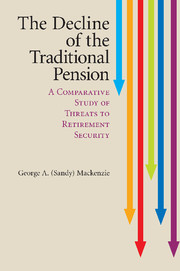Book contents
- Frontmatter
- Contents
- List of Tables
- List of Figures
- List of Boxes
- Acknowledgments
- Introduction
- PART ONE
- PART TWO
- 6 The Causes of Decline
- 7 Policies to Address the Decline of the Traditional Pension
- 8 Summary and Conclusions
- Appendix 1 Ten Country Profiles
- Appendix 2 Mathematical Treatments and Derivations
- Glossary
- References
- Index
8 - Summary and Conclusions
Published online by Cambridge University Press: 05 June 2012
- Frontmatter
- Contents
- List of Tables
- List of Figures
- List of Boxes
- Acknowledgments
- Introduction
- PART ONE
- PART TWO
- 6 The Causes of Decline
- 7 Policies to Address the Decline of the Traditional Pension
- 8 Summary and Conclusions
- Appendix 1 Ten Country Profiles
- Appendix 2 Mathematical Treatments and Derivations
- Glossary
- References
- Index
Summary
What Happened…
In the Anglo-Saxon Countries
In the United States, the United Kingdom, and Canada, the traditional pension's coverage of the workforce has suffered a serious decline, albeit less in Canada than in the other two countries. The decline has been underway for several decades, but in the United Kingdom its pace quickened alarmingly after 2005. As of 2007, the coverage of the traditional pension plan is only 17 percent in the United States, 30 percent in the United Kingdom (15 percent if only private-sector coverage is considered), and 34 percent in Canada (20 percent if only private-sector coverage is considered). High rates of coverage in the public sector help sustain overall coverage in all three countries, even in the United States, where the traditional pension plan's share of private-sector coverage is estimated to be only 10 percent.
The diminished standing of the traditional plan is associated with a decline in the overall rate of coverage of employer-provided plans in both Canada and the United Kingdom. In the United States, the overall rate of coverage has remained at about one in two workers despite the growing importance of 401(k) plans. Nonetheless, the role of annuitized pension benefits at the second tier has declined in all three countries. It is doubtful whether this decline in the role of annuitization at the second tier is compensated or offset by an increase at the third tier. The balances of voluntary private saving plans are typically not converted into annuities.
- Type
- Chapter
- Information
- The Decline of the Traditional PensionA Comparative Study of Threats to Retirement Security, pp. 205 - 214Publisher: Cambridge University PressPrint publication year: 2010



